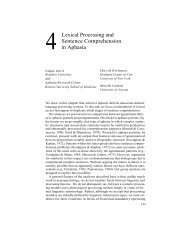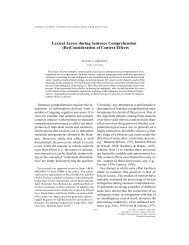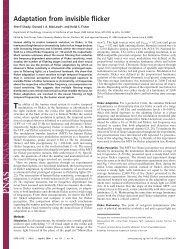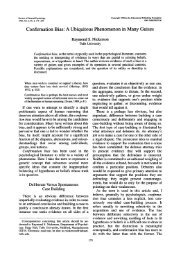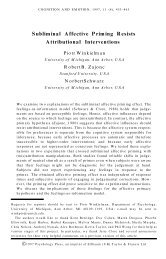Chapter 9 Moving verbs in agrammatic production
Chapter 9 Moving verbs in agrammatic production
Chapter 9 Moving verbs in agrammatic production
You also want an ePaper? Increase the reach of your titles
YUMPU automatically turns print PDFs into web optimized ePapers that Google loves.
170 Grammatical disorders <strong>in</strong> aphasia<br />
the two other cases were mildly impaired: the Swedish-speak<strong>in</strong>g Mr Bergman had only<br />
three word order errors with respect to verb position, and the Icelandic-speak<strong>in</strong>g Kiddi<br />
was very mildly impaired with an exceptionally low rate of errors <strong>in</strong> all measures, and<br />
therefore was not very <strong>in</strong>formative for <strong>agrammatic</strong> <strong>production</strong> analysis.<br />
6<br />
The relative order of the subject and the verb is kept either because they both stay <strong>in</strong><br />
VP or because both undergo short movement to a low maximal projection with<strong>in</strong> the<br />
<strong>in</strong>tact part of the tree - the subject to the specifier of the functional category, and the<br />
verb to its head.<br />
7<br />
A similar word order deficit with adjuncts <strong>in</strong> first position was also described by Hackl<br />
(1995) for German.<br />
8<br />
In SOV V2 languages such as German and Dutch there is abundant <strong>in</strong>dication as to<br />
whether or not verb movement to second position has taken place, because their I and<br />
V are both f<strong>in</strong>al and therefore any content of VP makes it possible to judge whether the<br />
erroneously produced non-f<strong>in</strong>ite verb has moved to a f<strong>in</strong>ite position. Th<strong>in</strong>gs are more<br />
complicated with SVO V2 languages, such as Scand<strong>in</strong>avian languages. Scand<strong>in</strong>avian<br />
languages (Swedish, Norwegian and Danish but not Icelandic) do not allow V-to-I<br />
movement, due to their poor <strong>in</strong>flectional paradigm. Yet, they do conta<strong>in</strong> V-to-I-to-C<br />
movement.<br />
9<br />
Interest<strong>in</strong>gly, this was also found for Hebrew-speak<strong>in</strong>g normal children and SLI<br />
children: they do not use <strong>in</strong>f<strong>in</strong>itives <strong>in</strong>stead of f<strong>in</strong>ite <strong>verbs</strong> even <strong>in</strong> stages where their<br />
English-, French-, Dutch- and German-speak<strong>in</strong>g counterparts do. (See Dromi, Leonard<br />
and Shteiman, 1993, for SLI children; Armon-Lotem, 1996; Berman and Armon-Lotem,<br />
1996, for normal children.)<br />
The preparation of this chapter was supported by a grant from the Israel<br />
Foundation Trustees.



